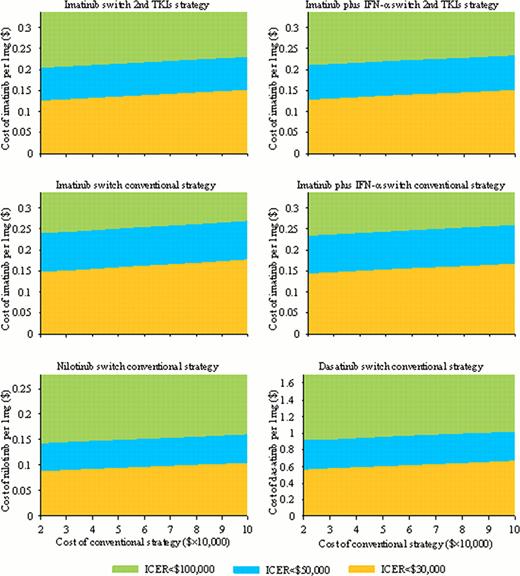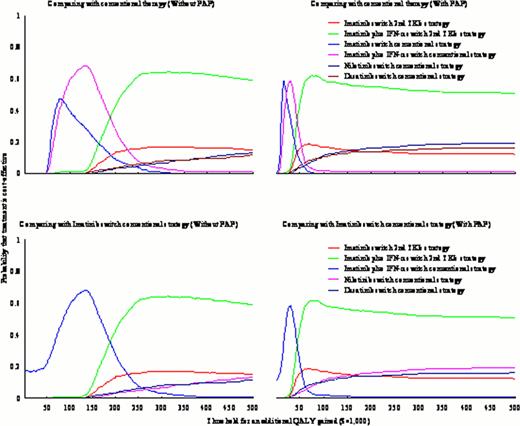Abstract
Abstract 4696
To evaluate the economic outcome of conventional and targeted therapies of patients with chronic myelogenous leukemia (CML).
Two Markov simulation models were designed to measure the cost and quality-adjusted life years (QALYs) for newly diagnosed CML patients whether to be administered conventional therapy or six tyrosine kinase inhibitors (TKIs) based strategies. Clinical and utility data were taken mostly from the literature by a MEDLINE search. Costs were based on local charges. The primary output was reported in terms of incremental cost-effectiveness ratios (ICERs). Sensitivity analyses were performed to examine the robustness of the model output. The impact of patient assistance program (PAP) was assessed.
The imatinib plus peginterferon-Á switch 2nd TKIs strategy yielded the most health benefits for newly diagnosed CML patients when compared with the conventional, imatinib switch 2nd TKIs, imatinib switch conventional, imatinib plus IFN-Á switch conventional, nilotinib switch conventional and dasatinib switch conventional strategies (figure 1). Marginal cost-effectiveness was $79,134 or $17,600 per QALY gained relative to conventional strategy without or with PAP (figure 2). Both the nilotinib and dasatinib based strategies were more expensive yet less effective than the alternative strategies and were therefore dominated. Model outputs were sensitive to the cost of TKIs.
Imatinib and imatinib plus peginterferon-Á based strategies are potentially more cost-effective and 2nd-generation TKIs may be preferred in the setting of imatinib failure. Patient assistant program in health resource limited setting might notably improve the economic outcome of TKIs based therapies.
The two-way sensitivity analyses conducted by varying the price of TKI agents and the total cost of the conventional strategy. Each area represents a combination of TKI agent price and the total cost of the conventional strategy at which the target strategy is cost-effective relative to the conventional strategy.
The two-way sensitivity analyses conducted by varying the price of TKI agents and the total cost of the conventional strategy. Each area represents a combination of TKI agent price and the total cost of the conventional strategy at which the target strategy is cost-effective relative to the conventional strategy.
The cost-effectiveness acceptability curves stratified by Patient Assistance Program (PAP) in comparison with conventional therapy (top) and imatinib switch conventional therapy (bottom). The y-axis indicates the probability that a strategy is cost-effective across the willingness to pay threshold per QALY gained (x-axis).
The cost-effectiveness acceptability curves stratified by Patient Assistance Program (PAP) in comparison with conventional therapy (top) and imatinib switch conventional therapy (bottom). The y-axis indicates the probability that a strategy is cost-effective across the willingness to pay threshold per QALY gained (x-axis).
No relevant conflicts of interest to declare.
Author notes
Asterisk with author names denotes non-ASH members.



This feature is available to Subscribers Only
Sign In or Create an Account Close Modal